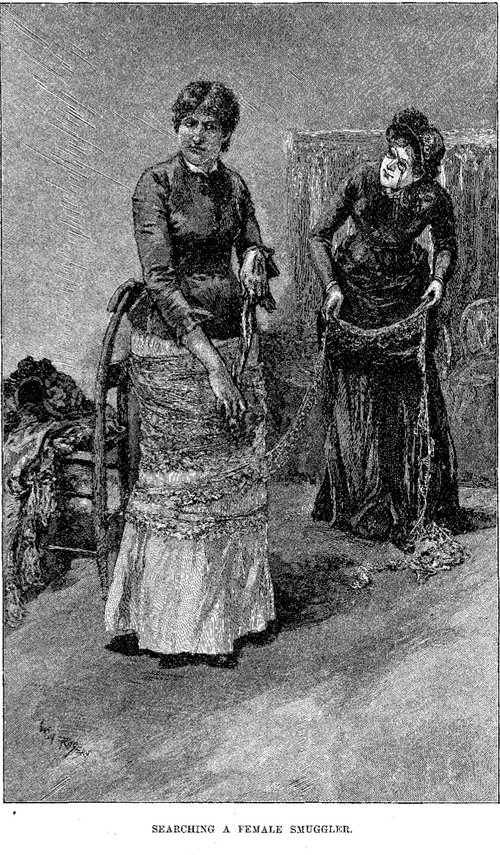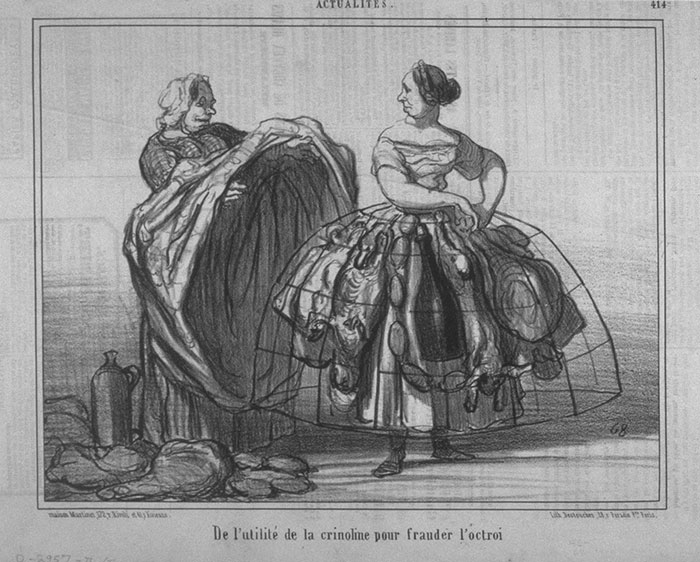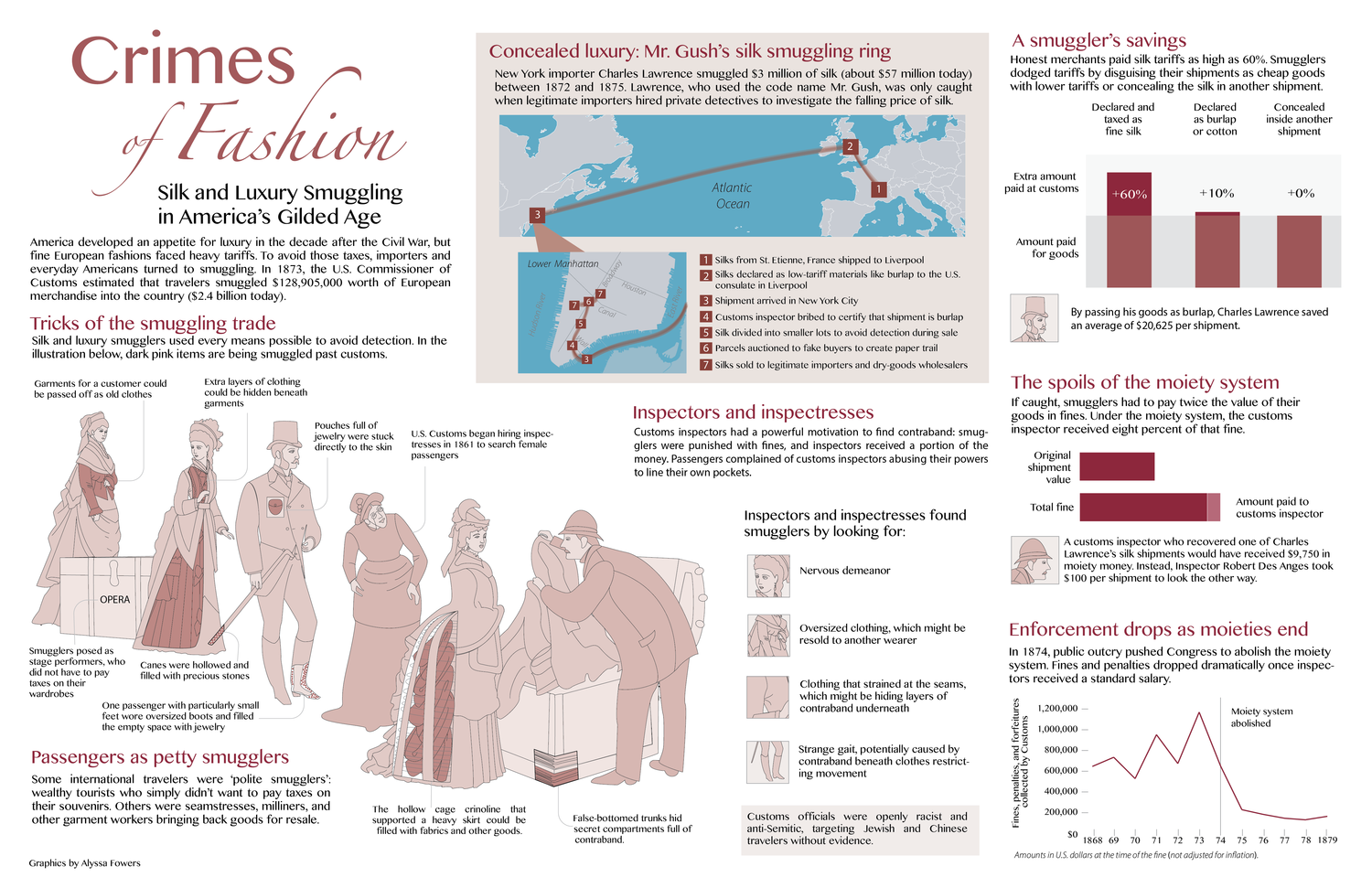How Women Used Their Skirts to Smuggle Goods in the Victorian Era
When I covered the rise and fall of the bustle in a post late last year, one of our readers brought up a good point. The extra space under the skirts of the popular dress styles of the mid to late 1800s would have provided ample room for smuggling goods. This reader wasn’t wrong. In fact, during my research for the post I had stumbled upon a podcast episode from the fashion historians over at Dressed that discussed the exact topic. Because I know our readers love the more colorful parts of fashion history I decided to take a closer look at Victorian crimes of fashion.
Female smugglers did, in fact, have a bit of a hay day in the years following the Civil War and did in fact use their skirts to conceal goods. Their reasons for smuggling and the efforts they took to move contraband was as much a source of humor back then as it was today. Here is a bit of what I learned.
Profile of a Female Smuggler During Victorian Times
Whether working alone, with a male cohort, hired by a smuggling ring, or organizing the ring themselves, smuggling was one crime in Victorian times with a high percentage of female perpetrators. The profile of a female smuggler was fairly simple to create, however. Lady smugglers nearly always fell into one of three categories:
American dress makers
Following the Civil War dressmaking grew into a thriving industry and one that became increasingly competitive. With the Industrial Age picking up greater speed each year a new brand of dressmaker began to emerge: the well-to-do entrepreneur. These business owners were the dressmakers highly sought after by the wealthy because of what they were able to offer: French designs and French materials.
In order to stay competitive, these women needed to show that they could create the most trendy French fashions of the time. This required dresses imported from France to be used as models and research trips to gain acumen. Oh, and a few dozen yards of actual French lace or several dozen pairs of French gloves didn’t hurt either.
American Milliners
Perhaps even larger in the post Civil War years was the demand for French millinery work. In a trend that had perhaps started as far back as with Marie Antoinette, the French dominated on-top-of-the-head fashion.
The trouble milliners ran into was not just that their customers wanted French fashions, but they also wanted French notions to adorn their custom hats. French lace, flowers, and ribbon were of particular demand. The next problem milliners faced was customers demanding authenticity without the price tag.
In her charming 1867 memoir Diary of a Milliner, Belle Otis recounted many amusing stories of customers hungry for the latest fashions and best materials at a low price. In one account she writes:

Image from Fashion Studies Journal
“Some contenances became thoroughly repulsive under the influence of contending emotions, — anxiety to obtain something to modify natural asperities, and feat or parting with the money to pay for it.
The prominent feature in to-day’s trade has been the surprise expressed at the rise in prices. The war has raised the price of bonnets as well as of everything else, and it is like a drama to witness the contortion, and hear the exclamations of a novice in the present era of shopping.“
Smuggling was an obvious solution to this combination of quandaries and milliners set out to gather their French trimmings and return to their shops with the lusted-after frills tucked in their skirts.
Poachers and thieves
Then, of course, we have the poachers and thieves. Women attempting to bring items through customs for personal use or to sell.
My favorite of these stories is of a woman returning from Canada with a cuckoo clock. Thanks to the blog Blue Anchor Corner I extracted the following passage from an 1865 edition of an English newspaper:
“The lady fastened the timepiece securely to her hoops and started on her homeward journey. Arriving at the Custom-house the officer found nothing contraband among her effects, and was passing to the next traveller when a loud wh-r-r-r was heard under the lady’s skirts. The strange noise was kept up for the full space of a minute; but to the lady it seemed an hour, and she became tremulous and excited.
The Custom-house officer, not daring to lay hands on the woman ‘save in the way of kindness’, obtained an iron rod, with which he felt around the crinoline for the concealed clock, and succeeded in bringing it down.”
Why the Smuggling?
Taxes and Tariffs
In regards to dressmakers and milliners, the first issue driving the desire for otherwise legitimate businesswomen to circumvent the rules were the steep taxes and tariffs of the time. Such fees skyrocketed in the years following the Civil War to more than 50% higher than what they had been. Textiles, lace, silk, and dresses themselves were hit with especially high duty fees. With the need to keep costs manageable, women running dress and millinery businesses simply couldn’t afford to comply.
When asked on the Dressed podcast why these women felt so comfortable “stealing” given their otherwise traditional Victorian morals, fashion historian Hind Abdul-Jabbar responded: “I think this is different because this isn’t necessarily stealing, they bought these items, so they felt like they already paid for these, so they don’t really understand why they’re being almost punished to pay these exorbitant fees when they come back home…they just found it incredibly unfair.” Abdul-Jabbar also pointed out that this, combined with some women’s feeling that they were being left out of the political arena and therefore didn’t feel as obligated to comply with unfair laws that impacted their love of nice things or need to support themselves.
A Lust for French Fashion
The absolute obsession for French fashions required a dressmaker or milliner to either figure out a way to offer it, or simply cease to be relevant. It would still be a few years before America would become a main trendsetter, though that time was right around the corner.
In another charming story from Diary of a Milliner, Belle Ottis tells of a customer who returned to the shop no less than four times after the purchase of her hat. The reason? To double (and triple) check that the flowers Belle had adorned the hat with were really French. On the fourth time she stated that her cousin didn’t think the flowers were French. To appease her, Belle found a French label in the back of the shop, attached it to a bunch of similar flowers, and presented it to her. The customer left satisfied that she had authentic French flowers and strutted away with pride.
Did Belle con the woman? According to Belle, she had actually performed an act of service. My favorite passage from the book reads:
“I really think I performed a virtuous and amiable act in humbugging the little thing. She was in depths of trouble and very miserable when she came into the store. I relieved her mind of its burden, and sent her on her way rejoicing. I congratulate myself that this day’s low-descending sun has seen from my hand one worthy action done.”
Crimes in crinoline
For a few decades, women’s fashions were quite suitable for concealing malleable goods such as fabrics and notions. Two undergarments, in particular, the petticoat and the crinoline, were particularly useful.
I discovered so many stories of women using their petticoats to smuggle in goods to soldiers during the Civil War that I will be covering the topic in my next blog post. The crinoline, on the other hand, has some funny stories worth mentioning now.

- A 1860s edition of a newspaper from Toulouse reported a woman attempting to conceal “no fewer than twelve partridges” in her crinoline.
- Around the same time, a woman by the name of Elizabeth Lorinz was caught with “5lbs of cigars, 9lb of foreign manufactured tobacco, a quarter of a pound of tea, and half a gallon of Holland gin” attached to the inside of her crinoline, in addition to £12,000 of jewels.
- Unable to afford your train ticket? One possibly apocryphal story tells of a woman unable to purchase a ticket who was met by a Good Samaritan who simply let her hide away under her crinolin, “even as a hen gathers her chickens under her wing.”
How to Catch a Lady Smuggler
The prevalence of female smugglers became such a problem for the U.S. Customs House that common red flags became well-known to officers. One was the type of attire a woman was wearing and whether or not it was appropriate for traveling.
The Ladies’ Book of Etiquette, a Manual of Politeness, written in 1860 states that:
“A lady will always dress plainly when traveling. A gay dress, or finery of any sort, when in a boat, stage, or car, lays a woman open to the most severe misconstruction. Wear always neutral tints, and have the material made up plainly and substantially, but avoid carefully any article of dress that is glaring or conspicuous. Above all, never wear jewelry, (unless it be your watch,) or flowers; they are both in excessively bad taste. A quiet, unpretending dress, and dignified demeanor, will insure for a lady respect, though she travel alone from Maine to Florida.“
Extremely formal clothing, therefore, was a sign that a woman may be wearing something she had not declared, was bringing back for a customer, or was being worn to conceal goods.
Other known red-flags included:
- A traveler walking oddly
- Clothing that was quite tight
- A woman who seems overly nervous
- Clothing that appears too large for the wearer
Enter the Inspectress
Profiling a female smuggler helped with identifying potential offenders, but it didn’t mean they could be caught. Standards of morality were such at the time that conducting searches would have been too uncomfortable for most officers to bear. It would also mean putting his own reputation at considerable risk. Enter the Inspectress.
One thing I love about this story is that the audacity of one group of working-class women created an entirely new career for another. While women had never before been employed at the Customs House, they were now brought in to conduct such “sensitive inspections.” This move may have slowed the practice of some under the skirt smuggling, but as we have seen before, fashion trends were really in control. The slim skirts and fitted looks of the early 1900s soon took over, removing the opportunity for much on-person smuggling.
Stay tuned for next week’s blog post where I will discuss the use of hoop skirts to smuggle contraband during the Civil War.
Thank you to Alyssa Fowers for the use of her informative and original image.
For further reading:
The Victorian Skirt: From Petticoat to Bustle Part 1














Janice, I’m sorry. I just saw your question. My source is the writings of my great grandfather, who was just a little boy then. He wrote down several stories from his childhood. His mother was a remarkable woman with a lot of determination and grit.
Oh my! This story takes travel to a whole new level! I think I like my own car, throw my bags in the back, and off we go! So much less sophisticated than what these women endured!
Thank you so much for the story, Paula! is there an online source that I can reference or place where I can learn more? Did she use her skirts to smuggle it in? Fascinating and brave!
During the Civil War some soldiers were being held in a nearby jail. My great-great grandmother felt that they were being held unjustly. She was able to smuggle a saw to them, thereby aiding in their escape!